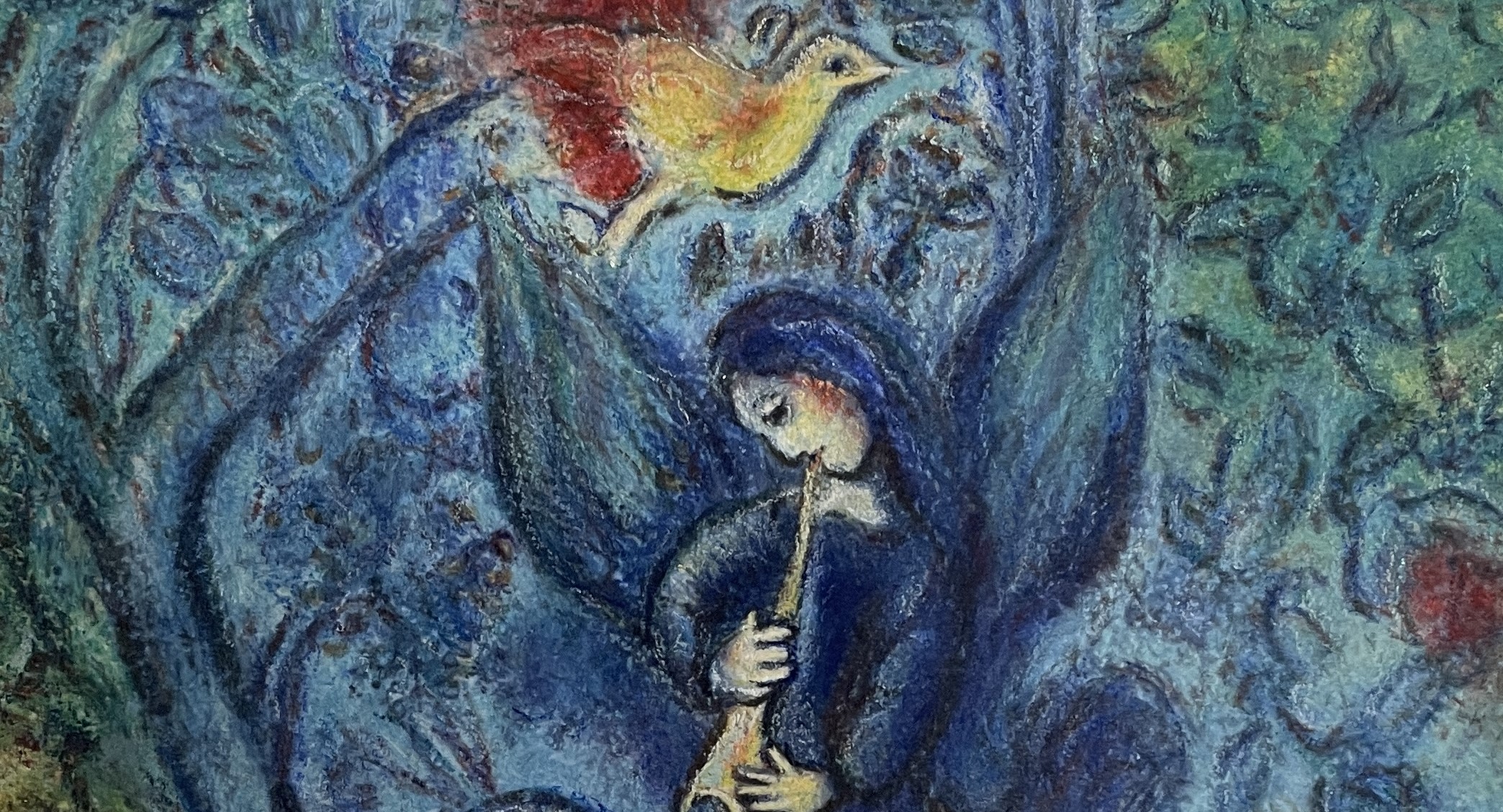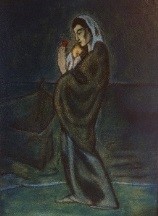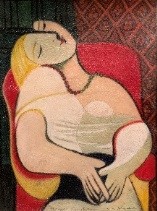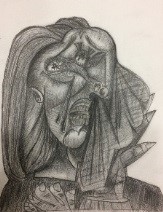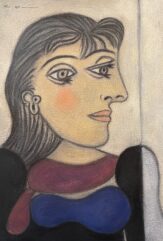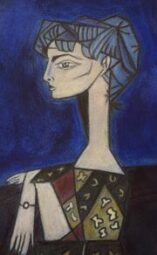日本語-Englishー台灣華語
パブロ・ピカソ「海辺の母子像」
ピカソの代表作とされるゲルニカは、かつてプラド美術館の別館にあった。そこにはゲルニカだけが飾ってあった。白黒の画面は確かに大きく、これを二ヶ月そこそこで仕上げたピカソのエネルギーは並大抵のものではないが、私はその絵から空爆に対する激しい怒りを感じることができなかった。ピカソは日記のように絵を描くが、そこにはいつも個人的な感情が殺されていて、心まで迫まってくるものがない。
ピカソの絵の中で、唯一彼の感情を強く感じることができるのが、青の時代の絵だ。ピカソは青の時代があるからこそ不滅に残ったのだと私は思う。青の時代の絵はピカソの絵の中でもとりわけ高価だが、それは膨大なピカソの絵の中で数が限られているというばかりでなく、ピカソの純粋な感情が赤裸々に描かれている、魂に触れる絵だからだと思う。ピカソはどん底の貧しさと孤独の中で、底辺に生きる貧しい人々、普通の世界から切り離された無感動な人々の姿を描き始める。盲人、乞食、娼婦、アル中、そして画家。自らと同じ境遇の人物を描くことで、生きる勇気を取り戻そうとする。青の時代の絵には深い沈黙が漂っている。そこには生きる望みを失わせてしまう暗黒の絶望がある。カンディンスキーは言っている。「青は天上の色である。それが極度に濃くなり黒に近いまで沈んでしまうと、そこには非人間的な悲哀の響きを伴ってくる」と。青は人間の苦悩と孤独を現わす色だが、同時にどこか地上を離れた天上の神秘が宿り、救済をもたらしてくれる色でもある。ピカソは海よりも深い青の中に、人生の深淵を見出そうとしたのだろうか。来る日も来る日も青い絵を描き続ける。その歳月は三年に及ぶ。親友カサヘマスの死の淵を覗いたその果てに、ピカソは魂の色に到達する。人は絶望の淵に佇み、絶望を克服しようと決意した時、新たな希望を見出すものである。
青の時代は「ラ・ビィ(人生)」を描くことで終焉を迎える。親友カサヘマスの生と死を結晶させたその絵によって、ピカソは自らの再生を誓う。罪悪も背徳も別離も、自らの画業の前には些細なことでしかない。天がピカソに画家としての壮大な使命を与え、それに相応しい能力を与えてくれたことに感謝したに違いない。ピカソはその時、画家としてあらゆるエゴを貫き通す決意をしたのだ。しかしピカソが真に青の時代を抜け出せたのは、フェルナンド・オリビエとの出会いがあったからだと私は思う。ピカソは他の画家から刺激や触発を受けても、影響されるということはない。唯一愛によって影響を受ける画家なのだ。
ドラ・マールとの別れが「泣く女」を生み、マリー・テレーズとの出会いが「夢」を生みだした。ピカソは欠陥の多い身勝手な人間ではあったが、愛と絵がこれほど一体となった画家はめったにいない。弱音を吐かず、挫折を知らないピカソが、唯一心情を吐露した青の時代の絵を観る度に、私はピカソを見直すのである。
この「海辺の母子像」は、箱根のポーラ美術館にある。青の時代のピカソの中でも飛びぬけて素晴らしい絵である。画面全体が光溢れる黄色に覆われ、その上を深い藍色で描き込んである。そのため青い画面は意外にも絶望の中に光を垣間見せる。画集で観ると母親の表情はとても怖い印象を持つが、実見するとほのかに優しさを称えている。母に抱かれた赤子は柔和な表情をして安らかに眠っている。夜の海辺に浮かぶ舟は、シャバンヌの「貧しき猟師」に出てくる舟を想起させるが、この小舟の舳先は岸辺を向いており、これから彼岸に漕ぎ出すのではなく、彼岸から漕ぎ戻ったのだろうか。抱かれた赤子は未熟児で危うく命を落とすところを、辛うじて生き長らえたのかもしれない。月光にわずかに照らし出された母親は、一輪の赤い花を天にかざして一心に神に感謝しているのだろう。この絵には未来への微かな希望が感じられる。この赤子は新たに生まれ変わったピカソ自身を象徴しているのだと私は思う。
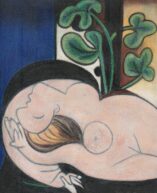
Nude on a Black Chair
黑椅子上的裸女
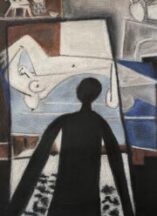
Picasso Standing by a Nude
站在裸女旁的畢卡索
Mother and Child by the Sea
Pablo Picasso’s Guernica, considered one of his masterpieces, was once housed in an annex of the Prado Museum. There, Guernica was the sole exhibit. The black and white canvas is indeed large, and the energy Picasso put into completing this work in just about two months is extraordinary. However, I could not feel the intense anger against aerial bombing from the painting. Picasso paints like keeping a diary, but his personal emotions are always suppressed, lacking an impact that reaches deep into the heart.
In Picasso’s paintings, the only time I can strongly feel his emotions is during his Blue Period. I believe it is the Blue Period that has immortalized Picasso. Paintings from the Blue Period are especially valuable not just because they are limited in number within Picasso’s vast body of work, but because they depict Picasso’s raw emotions, touching the soul. Amidst extreme poverty and solitude, he began portraying poor people living at the margins, individuals disconnected and unfeeling from the ordinary world – blind men, beggars, prostitutes, alcoholics, and painters. By depicting those who shared his circumstances, he sought to regain the courage to live. There is a profound silence in the Blue Period paintings, filled with a dark despair that robs one of the hope to live. Kandinsky said, “Blue is the color of the heavens. When it becomes intensely deep, verging on black, it evokes a non-human sorrow.” Blue represents human suffering and solitude, yet it also carries the mystery of the heavens, offering salvation. Perhaps Picasso sought to find life’s abyss in the deep blue, deeper than the sea. Day after day, he continued to paint in blue, a period lasting three years. At the end of it, having faced the depths of his friend Casagemas’s death, Picasso reached the color of the soul. Standing at the brink of despair and deciding to overcome it, one finds new hope. The Blue Period concludes with “La Vie,” capturing the life and death of his friend Casagemas, through which Picasso vows his own rebirth. Sins, immorality, and separation are trivial before his artistry. Surely, he must have been grateful for the grand mission and the corresponding talent bestowed upon him by the heavens. At that moment, Picasso resolved to persevere through all egos as a painter.
However, I believe Picasso truly emerged from the Blue Period due to his encounter with Fernande Olivier. Picasso, unaffected by other painters’ stimulation or inspiration, is influenced solely by love. The separation from Dora Maar gave birth to “The Weeping Woman,” and the meeting with Marie-Thérèse inspired “The Dream.” Though Picasso was a flawed and selfish man, rarely does one find a painter in whom love and art are so unified. Every time I see a painting from the Blue Period, where Picasso uniquely revealed his heart without complaint or defeat, I reassess my view of him.
“The Maternity by the Sea,” located in the Pola Museum of Art in Hakone, stands out among Picasso’s Blue Period as exceptionally beautiful. The entire canvas is covered in a radiant yellow, over which deep indigo is painted. Thus, the blue canvas surprisingly reveals light amid despair. In art books, the mother’s expression seems terrifying, but in person, it exudes a subtle kindness. The child held by the mother wears a gentle expression, peacefully asleep. The boat floating on the night sea reminds one of the boat in Chavannes’s “The Poor Fisherman,” but the prow of this small boat faces the shore, suggesting it has returned from the other side, not setting out. The held child, perhaps a premature infant who narrowly escaped death, might have just managed to survive. The mother, faintly illuminated by moonlight and holding a single red flower up to the heavens, seems to be deeply thanking God. This painting conveys a faint hope for the future. I believe the child symbolizes Picasso himself, reborn anew.
巴布羅·畢卡索《海邊的母子像》
被認為是畢卡索代表作之一的《格爾尼卡》曾經陳列在普拉多美術館的分館。那裡僅展示了《格爾尼卡》。雖然畢卡索在短短兩個月左右的時間內完成了這幅巨大的黑白畫作,展現了非凡的能量,但我無法從中感受到對空襲的強烈憤怒。畢卡索像寫日記一樣繪畫,但總是將個人情感消除,缺乏直達心靈的力量。
在畢卡索的畫作中,唯一能強烈感受到他情感的是他的藍色時期的作品。我認為,正是因為有了藍色時期,畢卡索才得以永垂不朽。藍色時期的畫作不僅在畢卡索的作品中格外昂貴,不僅因為這些作品在他龐大的作品集中數量有限,更因為這些畫作裸露了畢卡索純粹的情感,是觸及靈魂的作品。畢卡索在極度貧窮和孤獨中開始描繪生活在底層、被普通世界隔絕的無感覺的人們:盲人、乞丐、妓女、酗酒者和畫家。通過繪畫與自己處境相同的人物,他試圖重新獲得生存的勇氣。藍色時期的畫作中流淌著深沉的寂靜,充滿了讓人絕望的黑暗。 康定斯基說過:“藍色是天堂的顏色。當它變得極其濃郁,幾乎接近黑色時,會帶來非人類的悲傷。”藍色代表人類的苦難和孤獨,但同時也寄寓了超脫地面、居於天堂的神秘與救贖。畢卡索或許試圖在比海洋還要深的藍色中發現生命的深淵。日復一日,他持續繪製藍色的畫作,這一時期持續了三年。在望穿秋水的朋友卡薩赫馬斯的死亡之後,畢卡索達到了靈魂之色。當人們站在絕望的邊緣,決心克服絕望時,就會發現新的希望。藍色時期以繪製《生活》畫作而結束,通過這幅凝聚了親友卡薩赫馬斯生與死的畫作,畢卡索發誓重新開始。罪惡、背德、分離,在他的繪畫事業面前都顯得微不足道。畢卡索一定感激天賦予他作為畫家的偉大使命和相應的能力。那時,他決心以畫家的身份貫徹自己的一切自我。
然而,畢卡索真正走出藍色時期,我認為是因為遇到了費爾南多·奧利維耶。即使受到其他畫家的激勵和啟發,畢卡索也不會被影響。他是唯一通過愛受到影響的畫家。與多拉·瑪爾分手後創作了《哭泣的女人》,與瑪麗·特蕾莎的相遇創作了《夢》。畢卡索雖然是一個有許多缺陷的自私的人,但愛與畫作如此融為一體的畫家是極其罕見的。每當我看到畢卡索在藍色時期唯一抒發心情的畫作時,我都會重新評價他。
這幅《海邊的母子像》位於箱根的波拉美術館。它是畢卡索藍色時期中最為卓越的作品之一。整個畫面被光芒四射的黃色覆蓋,上面用深藍色繪製。因此,藍色的畫面意外地在絕望中透露出光明。從畫集中看,母親的表情給人一種非常恐怖的印象,但實際看到時,可以感受到一絲溫柔。被母親抱著的嬰兒面帶柔和的表情,安詳地睡著。漂浮在夜海上的小船讓人想起夏凡的《貧窮的獵人》中的船,但這條小船的船頭朝向岸邊,似乎不是即將駛往彼岸,而是從彼岸返回。被抱著的嬰兒可能是一個早產兒,險些喪命,但勉強存活下來。僅被月光微微照亮的母親,可能正在全心全意地向天祈謝。這幅畫中可以感受到對未來的微弱希望。我認為,這個嬰兒象徵著新生的畢卡索自己。

